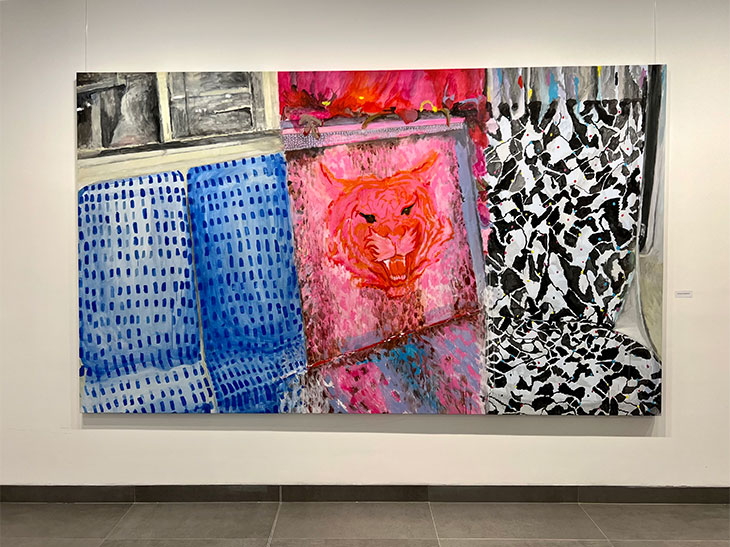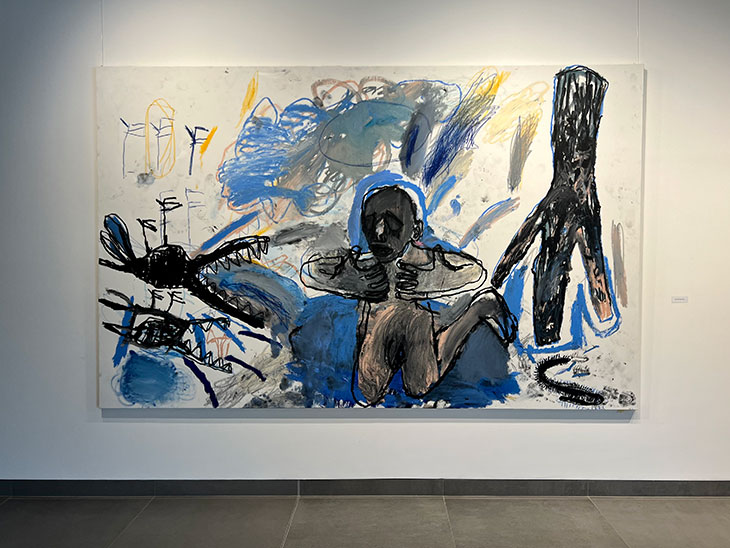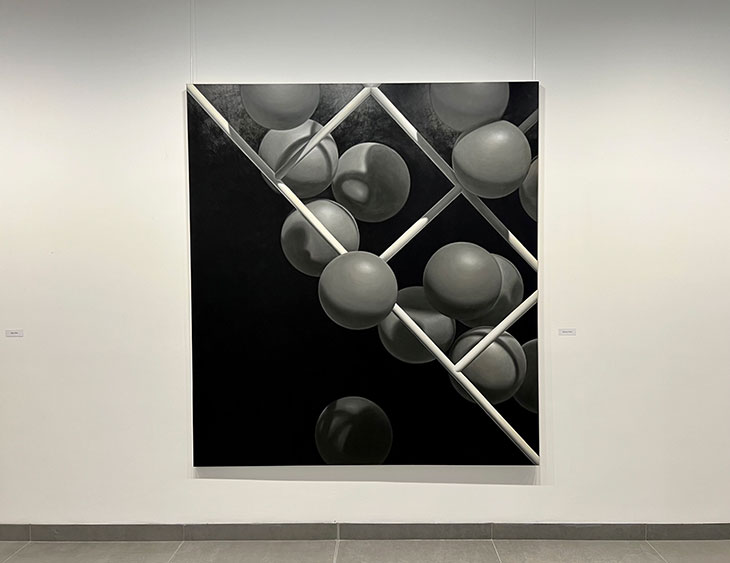
In the heart of Belgrade, Gallery Zvono stands as a beacon for contemporary and innovative art, representing a myriad of voices that echo the vibrant energy of the city’s art scene. With a steadfast commitment to nurturing and promoting emerging talent, the gallery has cultivated a space where artists and art enthusiasts converge to exchange ideas, perspectives, and inspirations.
ART
Editor Katarina Doric talks to the founder of Gallery Zvono, Ljiljana Tadic, about her personal relationship to art, her experiences with recognizing talented artists, and the future vision for the gallery. Through the conversation, Ljiljana unveils the passion, intuition, and dedication that continue to drive the gallery’s success, revealing unrecorded anecdotes and offering insightful advice for young artists embarking on their artistic journeys.


How did you decide to open the Zvono Gallery three decades ago, and what inspired you to devote yourself to art? – The decision to open the Zvono Gallery was motivated by our love for art and the desire to support young and talented artists who were facing difficult conditions in Serbia during the nineties. Our inspiration was to create a space where art could be freely expressed and appreciated, regardless of political and economic circumstances.
The Zvono Gallery is one of the oldest and most respected private galleries in Serbia, dedicated to promoting young and contemporary art. It was established in 1993 in Belgrade, and since then has organized over 300 exhibitions and projects, both in Serbia and abroad. Its mission is to support the development and affirmation of artists who have an original and critical approach to art, and to encourage dialogue and collaboration in the art scene.

How would you describe the evolution of the Zvono Gallery over these 30 years? What have been the most significant moments and turning points? – The evolution of the Zvono Gallery has followed the development of contemporary art in Serbia and the region, as well as changes in society and culture. Initially, we focused on presenting young artists who were graduating from the art academy and starting their careers. Later we expanded our program to include established artists, as well as international collaborations and projects. Some of the most significant moments and turning points were:
- The first exhibition of the Zvono Gallery in 1993, which gathered a group of young artists under the name “Zvono“.
- The first participation in the “Viennafair” art fair in Vienna in 2005, which marked our entry into the European art market.

If you could choose one artistic moment or work that the gallery presented, which had the strongest influence on the Belgrade art scene, what would it be? – It is difficult to choose just one artistic moment or work that the gallery presented, which had the strongest impact on the Belgrade art scene, because we believe that all our projects have had their significance and influence. However, if we had to choose one, it would probably be the “Real Presence” project organized by Biljana Tomi? and Dobrila Denegri. It was an international workshop project that brought together over 200 young artists from around the world, who worked, created, and exhibited together in Belgrade. The project was inspired by the idea of the importance of presence and solidarity among artists in times of crisis and conflict.

How has the gallery overcome the challenges brought by time, such as economic crises, social changes, or the global pandemic? – The Zvono Gallery has overcome the challenges brought by time with the help of our passion, dedication, and professionalism, as well as with the support of our collaborators, partners, sponsors, and audience. We believe that art is essential for the development of society and culture, so we strived to maintain continuity and quality of our work despite economic crises, social changes, or the global pandemic. Of course, we had to adapt to new conditions and challenges, such as digitalization, globalization, or ecology, but we did this with enthusiasm and openness to new ideas and opportunities.
We believe that art is essential for the development of society and culture, so we strived to maintain continuity and quality of our work despite economic crises, social changes, or the global pandemic.
One of the biggest challenges we faced during 30 years of work was to remain faithful to our mission and vision while simultaneously tracking and responding to changes in art and society. We have learned that it is important to be flexible, but also principled, to be critical, but also constructive, to be useful to be innovative, but also traditional.

During 30 years of work, you must have encountered various challenges. Can you identify one challenge that has given you the greatest life lesson? – The life lesson we have received is that art is one of the most beautiful and most difficult professions, but also one of the most valuable and necessary for humanity.
What role do you think the Zvono Gallery has in the art scene of Belgrade and Serbia as a whole? – We believe that the Zvono Gallery plays an important role in the art scene of Belgrade and Serbia as a whole because it is a place where young and contemporary art is nurtured and promoted, where dialogue and collaboration are encouraged among artists, curators, critics, and the audience, where a bridge is built between the local and global context. The Zvono Gallery is also a place where cultural heritage and the history of art in Serbia are preserved and transmitted, where the public is educated and informed about current artistic trends and issues, where critical awareness and aesthetic taste are developed.

Can you tell us more about your personal relationship to art? Is there a piece or artist that particularly inspires you? – My personal relationship with art is very passionate and deep. Art for me is a way of life, a way of thinking, a way of feeling. Art gives me meaning, joy, and hope. It helps me understand myself, other people, and the world around me. Art opens up new horizons, new perspectives, new possibilities. Art poses questions, challenges, and dilemmas to me. It inspires me, motivates me, and transforms me. There are many works and artists that inspire me, but I would single out Radomir Damnjanovic Damnjan, a brilliant artist whose conceptual approach, humor, irony, and provocation have influenced my work at the Zvono gallery.
The life lesson we have received is that art is one of the most beautiful and most difficult professions, but also one of the most valuable and necessary for humanity.
Is there an anecdote or special moment at the gallery that remained unrecorded, but you would like to share with the public? – There are many unrecorded anecdotes, but I do not want to share them. And precisely these anecdotes and those wonderful moments are related to Radomir Damnjanovic Damnjan.

Your reputation for recognizing talented artists while they are still at the academy is already well known on the Belgrade art scene. Is it intuition or do you use some special criteria? – Thank you for the compliment. The reputation for recognizing talented artists while they are still at the academy is the result of passion, intuition, and our long-term work and experience in the art scene. We follow the work of art academy students, visit their exhibitions, talk to them and their professors, and follow their development and progress.

Given the long-term experience, what would you advise young artists who are just starting? – The advice we would give to young artists who are just starting is to be persistent, brave, and honest in their work. Art is a very demanding and uncertain profession, requiring a lot of work, learning, research, and experimentation. Therefore, it is important to have a clear vision and goal, to believe in yourself and your talent, not to fear criticism and failure, not to adapt to trends and expectations, but to follow your voice and your path. We also advise young artists to be open to collaboration, communication, and exchange with other artists, curators, critics, and the audience. Art is a dialogue, not a monologue. Therefore, it is important to get involved in the art scene, to follow what is happening in the world of art, to participate in exhibitions, workshops, residences, competitions, and other opportunities that are offered. This way, you will expand your knowledge, experience, and horizons, meet new people and ideas, get feedback, and support. In the end, we advise young artists to enjoy their work and to perceive it as an expression of themselves and their attitude towards the world.

How do you see the future of the Zvono Gallery? Is there a special project or idea that you plan to implement in the coming years? – We see the future of the Zvono Gallery as a continuation of our mission and vision, as well as an opportunity for new challenges and possibilities. Our goal is to remain one of the leading galleries in Serbia and the region, supporting and promoting young and contemporary art, and to connect and cooperate even more with international partners and institutions. We also want to improve our digital presence and accessibility, to attract and satisfy a wider and more diverse audience.

How would you describe the mission and vision of the Zvono Gallery, and has it changed over the years? – The mission and vision of the Zvono Gallery is to support and promote young and contemporary art in Serbia and the region, as well as to encourage dialogue and cooperation in the art scene. This mission and vision have not changed over the years, but only adapted to new conditions and challenges that have accompanied the development of art and society. The Zvono Gallery remains true to its principles and values, as well as to its audience and artists.
The anniversary exhibitions are now on see at Gallery Zvono, Visnjiceva 6, Belgrade, 11000 and Gallery Viline Vode, Viline vode BB, Belgrade, 11000.



















